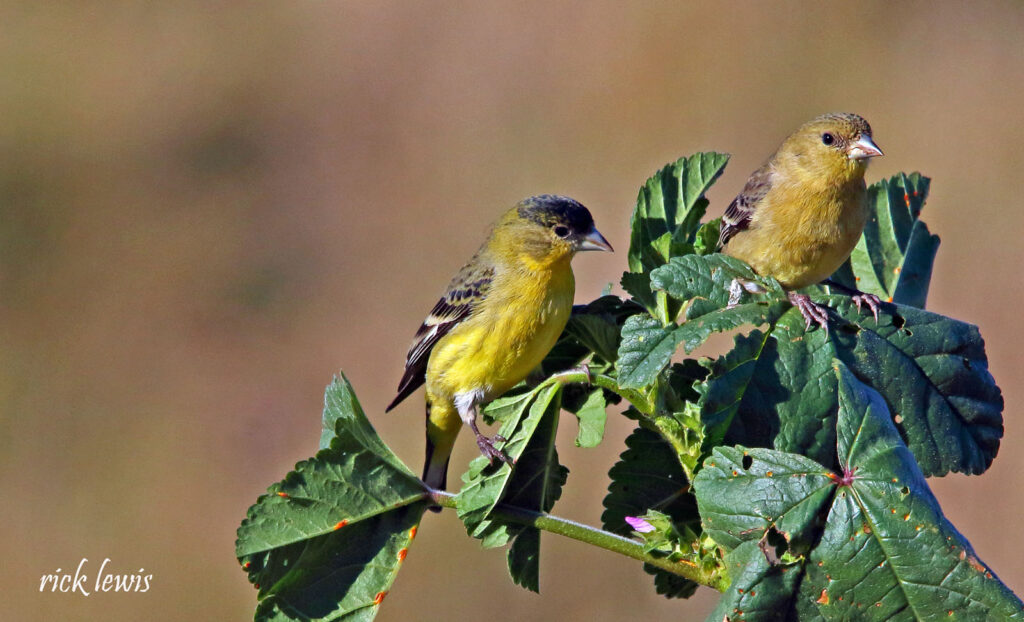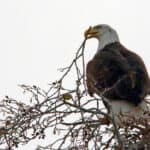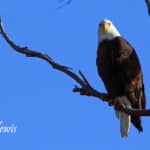Our bald eagles are thriving! They are giving much pleasure to many onlookers, well-wishers, photographers, birders, Corica Park staff, golfers, and the citizens of Alameda.

We are all thrilled to witness this magnificent spectacle taking place in our own backyard. The eagles have built two nests, plus another start, but they seem to prefer the nest on the North Course, which is undergoing renovation and restoration of the vibrant ecosystem at Corica Park.
We’d like to give a huge thank you to all the Corica Park staff for their support of the eagles. And we gratefully recognize the combined efforts of the many agencies, organizations, and individuals involved in monitoring this very special pair.

Corica Park is not only hosting the bald eagles, but other birds as well. Many other species call this home and/or regularly visit the site. Think of it as a kind of open space wildlife corridor providing habitat for birds and recreation for people. To protect the bald eagles and maintain the safety of patrons and staff, Golden Gate Audubon Society (GGAS) will sponsor authorized bird walks in the near future. Please visit the GGAS website for more information regarding guided bird walks. Pre-registration will be required.
I have chosen just a few other local denizens to feature. Each is important and exciting in its own right.
Red-shouldered hawk

Let’s start with the red-shouldered hawk (RSH), for which I have a particular affinity due to having a nesting pair just across the street for the last five years. The nest is located in Corica Park and I see them nearly every day—and hear them. They are exceptionally vocal and sometimes call repeatedly for minutes at a time. They’re often heard before they can be seen. They are hawks of woodlands and found frequently near water, so the large trees and ponds on the golf course attract them. In good light, the RSH is a spectacular sight to behold.
Green heron

This is a secretive and solitary bird and is always found near water. On the course, I’ve seen them near ponds and creeks. The green color may not be obvious—they can appear purplish with blue and red. Listen for their “skeow” as they fly along the banks of waterways. They raise their crest when disturbed and often flick their tails when walking.
Hooded merganser

Males are unmistakable with their white semi-circle embedded in their black hood. It’s very entertaining to observe these “hoodies” hunting as they dive for prey and surface again several feet away. Females are gray-brown with cinnamon crests. They eat mostly small fish, crustaceans, and insects. In addition to frequenting the golf course water bodies, they also can frequently be seen on the Bay Farm lagoons, particularly in the vicinity of the shopping center. They are only here in the winter—they spend their summer breeding season further north and east.
Lesser goldfinch

This small goldfinch can be found in weedy fields, gardens, woody streams, and at bird feeders throughout Alameda. A seed-eater, their song is musical and delightful. I find their call distinctive and search the area whenever I hear it. Lesser goldfinches are normally found in small flocks, feeding on seeds and then quickly flying off only to return within moments of having departed.
Merlin

The Sibley Guide to Birds describes the merlin, a small falcon, as pugnacious. Indeed, I’ve witnessed this little demon harassing a large flock of crows—roughly two-and-a-half times their size—successfully forcing many from their comfortable perch. Never did the merlin flinch! I’ve only seen merlin eat small birds, although I know they occasionally take insects. Merlins are birds of the forest, and only visit Alameda in winter, breeding further north.
Rick Lewis is a long-time member of the Golden Gate Audubon Society and other environmental organizations. He contributes often to Bay Area and Central Valley birding groups that promote wildlife and habitat conservation.



